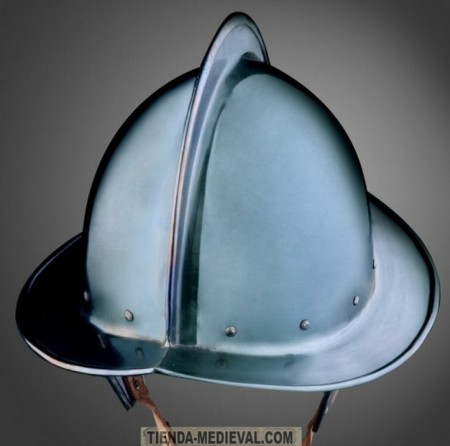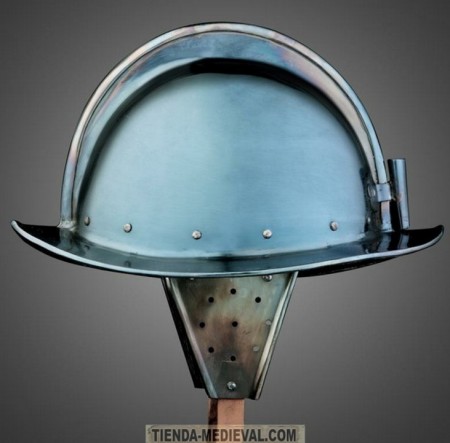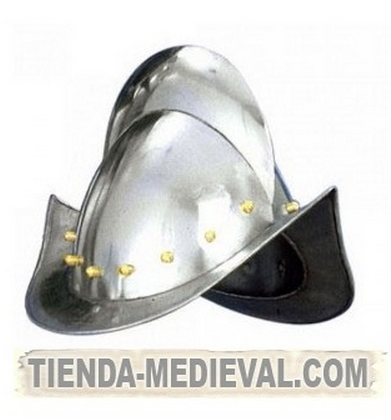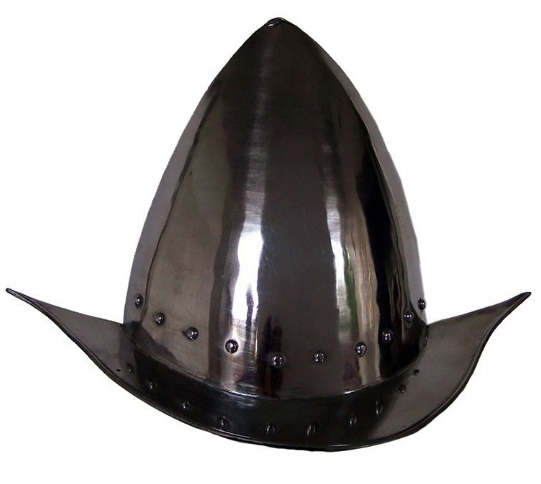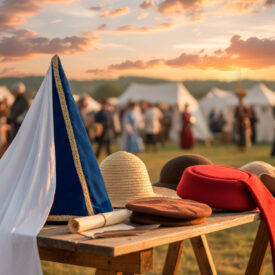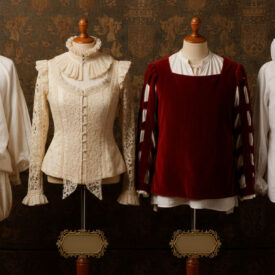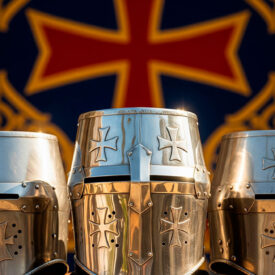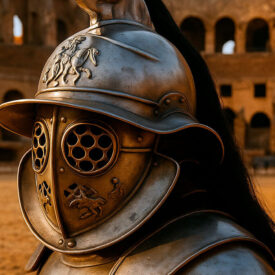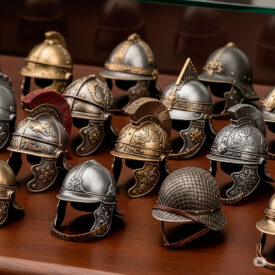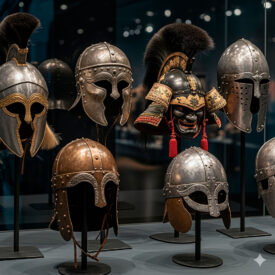When we think of the brave soldiers of the Renaissance or the legendary Spanish Conquistadors, a vivid image comes to mind: that of an unmistakable helmet, with its tall crest and curved brims. This is the morion, a piece of armor that, while iconic, holds a fascinating history of design, functionality, and evolution. Have you ever wondered what made it so special and why it became the preferred helmet on battlefields and in new worlds? Join us on this journey to the past to discover it.
The morion is a helmet that appeared in early 16th-century Castile, covering the heads of ancient knights; its shape was somewhat conical and it usually featured an almost blade-like crest. It also had a wide, upturned brim that ended in a point at the front and back. On the summit or crest, almost always curved, it presented either a sort of hook, nail, or button, or a sharp point. Although the morion was primarily used by infantry or foot soldiers, knights and notable individuals also wore it because it was lighter than the helmet and left the face uncovered for easier breathing.
Origins and the Curious Evolution of the Morion
Although the morion immediately evokes the Spanish Tercios, its history is more complex and intertwined with other types of medieval helmets. Its name, which is believed to come from the Spanish word “morra” (crown on the head), is not directly related to the Moors or oriental-style helmets, despite the phonetic similarity. This etymology, though debated, suggests a connection with the top of the head, which makes sense given its primary purpose.
From Cabasset to Morion: A Crucial Transformation
Armor experts suggest that the morion evolved from earlier helmets such as the cabasset and the great helm or kettle hat. Before the morion, the cabasset, widely used by Spanish infantry between the 16th and 17th centuries, was more spherical and flat, without crest or visor, and fastened with a chinstrap. It is often confused with the morion, but the latter is distinguished by its more conical shape and higher, upturned brims, as well as the characteristic crest. The morion is considered an improvement on the cabasset, incorporating a wide, upturned brim as well as the distinct crest that became its mark of identity.
This evolution was not linear. Different theories point to influences from the Burgonet or medieval chapel-de-fer. What is certain is that the Spanish morion benefited from the confluence of weaponry and metallurgical knowledge from various cultures (Italians, Germans, Flemish) on the Iberian Peninsula at the end of the 15th century. This blend of influences led to a design that was not only aesthetically distinctive, but also highly functional on the battlefield, adapting to the new forms of warfare emerging with the widespread use of gunpowder and infantry formations.
Anatomy of a Hero: Design and Types of the Morion
The classic morion is characterized by its half-almond silhouette or almond-shaped profile, with considerable height and a slender crest that distinguishes it. Its brims, wide and curving upwards at the ends, impart a distinctive elegance and extra protection. Although popularly associated only with the Spanish Tercios of the Golden Age and the conquerors of the Americas, the morion was used in most European countries in the 16th and 17th centuries. This widespread adoption underscores its efficiency and the versatility of its design.
Internal Components and Craftsmanship
Internally, for the comfort and safety of the soldier, the morion had an ingenious suspension system. The morion was a helmet in the shape of half an almond to help deflect blows, and inside it had a cabasset of three or four crossed straps, which rested on the head, ventilated the helmet, and cushioned vertical impacts. In addition to these straps, it included:
- A riveted leather or fabric strip that helped secure the system.
- A padded liner up to half an inch thick, made of coarse linen, wool, or horsehair, providing crucial cushioning against impacts and insulation from the heat of the metal.
As for its manufacture, the typical Spanish morion was handcrafted in one piece from tough 16-gauge steel, giving it superior durability and strength. This artisanal process demanded great knowledge and skill in forging, resulting in a high-quality piece of armor. Other morions, especially those imported from Germany or England, were usually made of two riveted pieces, easier and cheaper to produce but generally lower in quality and resistance.
The morions were made from three main parts. One, the main body of the helmet, obtained from a single piece by hammering sheet metal into the desired shape, or made from two halves in lower-quality models. Another, the brim, almost always with a thickened edge to stop cutting blows aimed at the face. Brims were made from two halves joined at the ends by welding. And the crest, if present. This was also formed by joining two halves because, due to its width, it was obviously hollow; otherwise, the morion would be extremely heavy with no added protection. Although there were morions with three crests—one main and two smaller ones on each side—in Spain, these were rarely seen, with nearly all Spanish morions having a single, moderately large crest, which simplified production and kept weight manageable.
Variations and Distinctions: Beyond the Standard Model
There were variations in the design of the morion, from those with pronounced crests to the pointed type, sometimes called “cabasset”. Helmets for regular soldiers were usually plain, reflecting their utilitarian nature and the need for mass production. However, the morions of leaders and officers often featured engravings, acid etchings, and tubes to hold decorative plumes. The plumes, typically from dyed male ostrich feathers, measured 50 to 60 centimeters long, and their colors (red, white, and yellow) could indicate the unit, as in the Imperial Guard of Charles V, serving not only as decoration but also as a badge of rank and affiliation.
Intelligent Defense: Functionality of the Morion in Battle
The morion was not just aesthetic; its design was an ingenious solution to the needs of the 16th-century battlefield. Its curved shape, both at the crest and the brims, was intended to deflect sword or spear blows, causing them to slide off and transfer energy away from the skull. The crest acted as a beam, boosting the deflection effect, similar to the function of the French Adrian helmet in World War I. This ability to deflect impacts was fundamental to a soldier’s survival in hand-to-hand combat.
Protection and Visibility: Key Combat Advantages
The morion offered key advantages on the battlefield:
- Full protection: It shielded the head, neck, ears, and shoulders, being especially useful in siege warfare where attacks often came from above, such as falling debris or projectiles thrown from walls.
- Enhanced vision and hearing: Being an open-face helmet, it allowed the wearer clear peripheral vision and hearing, vital for following commands in tight formations and reacting quickly to enemy movements. Morions were not worn with aventails, possibly to give users more freedom of movement and better hearing, especially as foot soldiers needed both comfort and efficiency, as well as the ability to hear orders in the heat of battle. For this reason, soldiers in the Tercios were strictly forbidden to shout in formation before battle. Only when in contact with the enemy were they allowed to shout “¡España!” or “¡Santiago!”
Resistance and Adaptability: The Morion in Various Scenarios
Besides direct protection, the morion stood out for its adaptability:
- Comfort and lightness: Despite being robust, it was comfortable and light enough to withstand the hot plains of southern Europe or the jungles of the New World. This made movement easier, especially for infantry and light cavalry, allowing soldiers to maintain agility during long marches and prolonged engagements.
- Resistance to firearms: Although not infallible, cuirasses (full armor sets, including the helmet) aimed to be musket-proof. At distances over 30 meters, they could resist a shot from an arquebus or musket. The helmet’s curve helped deflect projectiles, reducing impact energy and, in many cases, preventing penetration.
- Use with shields: To compensate for facial exposure, soldiers often combined it with a buckler or rodela (round shield) on the left arm, which could be raised to protect the face from thrusts or projectiles. These sets, often decorated to match, were common in infantry, creating an integrated defense system.
The morion was the standard helmet among the pikemen and arquebusiers of the Tercios, the elite infantry units of the Spanish Empire. Musketeers, on the other hand, who needed greater freedom to handle long weapons and protect themselves from the sun, typically dispensed with it in favor of the chambergo hat, a wide-brimmed hat that provided shade without restricting vision or movement. This distinction in usage highlights how equipment was adapted to the specific needs of each type of soldier and their role in the battle formation.
The Cradle of Steel: Production and Fame of the Spanish Morion
Production of the Spanish morion, like that of other armor and swords, gained great fame in Europe during the 16th century, renowned for its hardening and strength. The main factories and guild centers in Spain where these helmets were forged included cities and regions with a rich metallurgical tradition.
Production Centers and the Decline of Spanish Armory
Among the most important production centers of morions and other armor pieces in Spain were:
- Toledo: Famous for its swords, also producing high-quality armor.
- Bilbao: An important steelmaking center.
- Tolosa: With a significant armory tradition.
- Mondragón: Another key place in weapons production.
- Vergara: Contributing to the armory excellence of northern Spain.
- Calatayud: Known as the best producer of cabassets, making it a key location for the evolution toward the morion.
Interestingly, despite Spanish high quality, the Crown sometimes turned to European workshops (Italy, Germany, England) in the 17th century, as their morions were cheaper, though lower in quality. Spanish manufacturing declined from the 17th century onward, partly due to the development of firearms, which reduced demand for heavy armor, and the economic difficulties of the time, which led to the importation of cheaper military equipment. This change marked a transition in the military and economic strategy of the Empire.
The manufacturing process was laborious and included forging, shaping, and polishing. Polishing wheels, often water-powered, were an important investment and drastically reduced the time and effort needed for a smooth, shiny finish. This attention to detail and the artisanal effort invested in each morion reflect the importance placed on quality and durability in these protective pieces.
A Lasting Legacy: The Morion in History and Culture
The morion is not just a museum piece; it is tangible evidence of a bygone era. Its image became so deeply rooted in the European mind that even today, it is intrinsically associated with Spain and its Tercios, despite the fact that the term and the fully evolved design did not reach Spain until the mid-16th century. This association has been strengthened by artistic and film representations that have immortalized it as a symbol of Spanish courage and expansion.
From the Tercios to the Swiss Guard: An Everlasting Symbol
Its success was such that the morion became the first form of international helmet, adopted by soldiers, merchants, and colonists from Sweden to Japan (introduced by Portuguese traders). The popularity of the morion transcended social classes, being produced in various qualities and decorations, from the most humble infantryman to royalty, showing its versatility and acceptance across different social and military strata. This global reach is a clear indicator of its superior design and proven functionality in various climates and scenarios.
Even in literature, as in Cervantes’ famous Quixote, the protagonist uses a morion, highlighting its relevance at the time and its entrenchment in the collective imagination. This literary mention further solidifies its status as a significant cultural element, beyond its purely military function.
Today, the morion is still present in the collective imagination and in the ceremonial dress of units such as the Vatican’s Swiss Guard, although its modern versions are made of lighter materials and serve a purely symbolic function. It is a reminder of the discipline, courage, and military innovation of past centuries, keeping alive the memory of the soldiers who wore it with pride.
Care and Conservation: Preserving the History of the Morion
For those who own or wish to preserve a morion, whether a replica or a historical piece, proper care is fundamental. The greatest enemy of these metal helmets is moisture, which causes corrosion (rust). Proper conservation not only maintains the piece’s appearance, but also ensures its structural integrity and long-term historical value.
Practical Guide to Maintaining Your Morion
Basic care measures include:
- Regular inspection: It is essential to periodically check the morion for signs of corrosion or damage at an early stage. Small rust spots can quickly turn into bigger problems if not addressed promptly.
- Dry cleaning: Remove dust and dirt with soft brushes and microfiber cloths. Avoid excessive pressure to avoid damaging the surface, especially if the piece has delicate engravings or reliefs.
- Rust treatment: Light stains can be rubbed with a cloth soaked in anti-rust oil or a mixture of olive oil and fine sand, then polished with a clean, dry cloth. For more serious cases, where rust has penetrated deeply or there is material loss, it is highly advisable to consult an expert in metal restoration.
- Corrosion protection: Apply a thin layer of microcrystalline wax or acid-free oil (such as camellia oil or a light mineral oil) to create a protective barrier against moisture and oxygen. This should be done after each cleaning or handling.
- Proper storage: Store the morion in a dry, well-ventilated place, ideally with controlled humidity and temperature (18-20°C and 45-55% relative humidity). Avoid damp basements or attics with wide temperature fluctuations. If possible, use dehumidifiers or silica gel packs.
- UV protection: Avoid direct sunlight, which can damage organic materials like the helmet’s leather lining, causing it to crack or discolor.
It is crucial to remember that, in historical pieces, the patina (the natural layer which forms over time due to controlled oxidation and interaction with the environment) is part of its history and value, and should not be forcibly removed. Genuine patina is a sign of age and authenticity. If you have doubts or structural damage, the help of a professional restorer is indispensable to ensure ethical preservation and the helmet’s authenticity, guaranteeing that this piece of history is kept in the best condition for future generations.
The morion is much more than a simple helmet; it is a testament to military innovation, craftsmanship, and the rich cultural history of an era. Its intelligent design, combining protection, comfort, and striking aesthetics, allowed it to transcend borders and become the emblem of the bold Spanish Tercios and European expansion around the world. By understanding its development, function, and legacy, we can truly appreciate this iconic symbol of the Renaissance soldier. If you are passionate about military history and armor, or simply looking for a piece that captures the spirit of an era of great explorations and battles, we invite you to browse our selection of morions and other historical helmets.
Find the perfect piece to evoke the greatness of the Tercios and the Conquistadors in our collection of medieval morions and more medieval helmets, as well as historical helmets.

